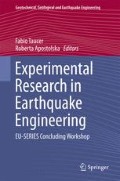Abstract
This chapter reports three recent developments aimed towards faster computations and more accurate execution of real-time hybrid simulations (RTHS). The first of these developments is a standalone RTHS system which can accommodate integration time steps as small as 1 ms. The fast execution feature eliminates the approximations that would be introduced by the application of a predictor-corrector smoothing technique and increases the applicability range of explicit integration methods. The second development is the use of an efficient equation solver in RTHS which reduces computation time. This efficient solver, which decreases the computation time by factorizing the Jacobian of the system of linear algebraic equations only once at the beginning of the simulation, is especially beneficial in RTHS which involves analytical substructures with large number of degrees of freedom (DOF). The third development is a novel use of a three-variable control (TVC) for RTHS on a shaking table configuration. Although the TVC, which employs velocity and acceleration control in addition to the typical displacement control, is commonly used in conventional shaking table tests, this development is the first application of TVC in RTHS.
Access this chapter
Tax calculation will be finalised at checkout
Purchases are for personal use only
References
Bonnet PA, Williams MS, Blakeborough A (2008) Evaluation of numerical time-integration schemes for real time hybrid testing. Earthq Eng Struct Dyn 37(13):1467–1490
Bursi OS, Gonzalez-Buelga A, Vulcan L, Neild SA, Wagg DJ (2008) Novel coupling Rosenbrock-based algorithms for real-time dynamic substructure testing. Earthq Eng Struct Dyn 37(3):339–360
Combescure D, Pegon P (1997) α-Operator splitting time integration technique for pseudodynamic testing error propagation analysis. Soil Dyn Earthq Eng 16:427–443
Conte JP, Trombetti TL (2000) Linear dynamic modeling of a uni-axial shaking table system. Earthq Eng Struct Dyn 29(9):1375–1404
Elkhoraibi T, Mosalam KM (2007) Towards error-free hybrid simulation using mixed variables. Earthq Eng Struct Dyn 36(11):1497–1522
Günay S, Mosalam KM (2013) Seismic performance evaluation of high voltage disconnect switches using real-time hybrid simulation: II. Parametric Study. Earthq Eng Struct Dyn 43(8):1223–1237
Horiuchi T, Inoue M, Konno T, Namita Y (1999) Real-time hybrid experimental system with actuator delay compensation and its application to a piping system with energy absorber. Earthq Eng Struct Dyn 28(10):1121–1141
Igarashi A, Iemura H, Suwa T (2000) Development of substructured shaking table test method. 12th world conference on earthquake engineering. Auckland, New Zealand
Ji X, Kajiwara K, Nagae T, Enokida R, Nakashima M (2009) A substructure shaking table test for reproduction of earthquake responses of high-rise buildings. Earthq Eng Struct Dyn 38(12):1381–1399
Lee S, Parka E, Mina K, Park J (2007) Real-time substructuring technique for the shaking table test of upper substructures. Eng Struct 29(9):2219–2232
Luco J, Ozcelik O, Conte J (2010) Acceleration tracking performance of the UCSD-NEES shake table. J Struct Eng 136(5):481–490
Mahin SA, Shing PSB (1985) Pseudodynamic method for seismic testing. J Struct Eng ASCE 111(7):1482–1503
McKenna F, Fenves GL, Filippou FC (2010) OpenSees. http://opensees.berkeley.edu
Mercan O, Ricles JM (2007) Stability and accuracy analysis of outer loop dynamics in real-time pseudodynamic testing of SDOF systems. Earthq Eng Struct Dyn 36(11):1523–1543
Mosalam KM, Günay MS (2013a) Hybrid simulations: theory, applications, and future directions. Adv Mater Res 639–640:67–95
Mosalam KM, Günay S (2013b) Seismic performance evaluation of high voltage disconnect switches using real-time hybrid simulation: I. System development and validation. Earthq Eng Struct Dyn 43(8):1205–1222
Mosqueda G, Stojadinovic B, Mahin S (2005) Implementation and accuracy of continuous hybrid simulation with geographically distributed substructures, Report No: UBC/EERC 2005–02, Earthquake Engineering Research Center, University of California, Berkeley
Nakashima M, Ishii K, Kamagata S, Tsutsumi H, Ando K (1988) Feasibility of pseudo-dynamic test using substructuring techniques. In: Proceedings of the Ninth World Conference on Earthquake Engineering. Tokyo, Japan
Nakashima M, Kato M, Takaoka E (1992) Development of real-time pseudo-dynamic testing. Earthq Eng Struct Dyn 21(1):79–92
Nakata N, Stehman M (2012) Substructure shake table test method using a controlled mass: formulation and numerical simulation. Earthq Eng Struct Dyn 41(14):1977–1988
Neild S, Stoten D, Drury D, Wagg D (2005) Control issues relating to real-time substructuring experiments using a shaking table. Earthq Eng Struct Dyn 34(9):1171–1192
Newmark NM (1959) A method of computation for structural dynamics. ASCE J Eng Mech Div 85(EM3):67–94
Nguyen NV, Dorka U (2009) Adaptive error compensation based on online system identification for real-time substructure testing. In: Proceedings of the 3rd international conference on advances in experimental structural engineering. San Francisco, CA
Ousterhout J (1994) Tcl and the Tk Toolkit. Addison-Wesley, Reading, Massachusetts, USA
Schellenberg AH, Mahin SA, Fenves GL (2009) Advanced implementation of hybrid simulation. Report No: PEER 2009/104. Pacific earthquake engineering research center, University of California, Berkeley
Shao X, Reinhorn AM, Sivaselvan MV (2011) Real-Time hybrid simulation using shake tables and dynamic actuators. ASCE J Struct Eng 137(7):748–760
Takanashi K, Udagawa K, Seki M, Okada T, Tanaka H (1975) Non-linear earthquake response analysis of structures by a computer-actuator on-line system (details of the system). Trans. of the Architectural Institute of Japan, 229:77–83
Thoen BK (2010) 469D Seismic digital control software, MTS Systems Corporation
Acknowledgements
Special thanks are due to Mr. Brad Thoen of MTS Corporation for providing the original Simulink model for TVC and to Dr. Frank McKenna for coding the efficient solver in OpenSees.
Author information
Authors and Affiliations
Corresponding author
Editor information
Editors and Affiliations
Rights and permissions
Copyright information
© 2015 Springer International Publishing Switzerland
About this chapter
Cite this chapter
Mosalam, K., Günay, S. (2015). Towards Faster Computations and Accurate Execution of Real-Time Hybrid Simulation. In: Taucer, F., Apostolska, R. (eds) Experimental Research in Earthquake Engineering. Geotechnical, Geological and Earthquake Engineering, vol 35. Springer, Cham. https://doi.org/10.1007/978-3-319-10136-1_6
Download citation
DOI: https://doi.org/10.1007/978-3-319-10136-1_6
Published:
Publisher Name: Springer, Cham
Print ISBN: 978-3-319-10135-4
Online ISBN: 978-3-319-10136-1
eBook Packages: Earth and Environmental ScienceEarth and Environmental Science (R0)

